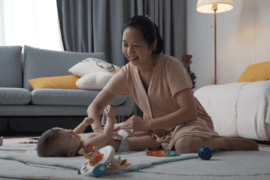By Kate Barnes
Digital dementia is a term I first came across recently. With a fourteen and twelve-year-old it’s been on my mind, can kids really get dementia?!
Over the past couple of weeks, I’ve been diving into the research #vestedinterest. This is what I’ve found… As you can imagine, it’s not good.
I have to admit that our kids have definitely experienced tech trance (or dare I say, tech rage). Technology and devices are entrenched in our lives, we can’t avoid them, yet there’s much we can do to manage them and make them safe. It’s an important conversation – whatever age your kids are (and for us as adults).
The statistics
Research is showing that in the USA 95% of children aren’t getting enough sleep, exercise or safe screen use, much of it’s related to device use. The average amount of time children are using a device is 7.5 hrs/day. For some teens, it’s 8 – 12 hours /day! You might’ve noticed it yourself. Driving past the bus stops as kids are waiting for the school bus or as soon as they leave school, devices out, necks craned, sucked into another world.
Mental illness, such as anxiety and depression is accelerating in our kids! The following can help paint a picture as to what’s going on.
What is digital dementia?
Briefly, digital dementia is the thinning of the brain cortex (outer layer of the brain) responsible for thinking, speech, feeling, decision making and processing information received from our senses.
Signs of digital dementia and excessive screen time;
- Changes in behaviour
- Poor memory
- Inability to focus
- ADHD, ADD, brain fog
- Aggression, irritability
- Poor social skills
- Tiredness and poor sleep
- Lack of confidence and so much more.
Our children’s’ brains are still developing and therefore so much more vulnerable to what we expose them too, especially the effects of technology and digital devices.
The other effects are equally alarming & are contributing to digital dementia;
- Constant stress on the body. This is due to poor posture. The craned neck and curved spine signal to the body a state of stress i.e. fight and flight. This makes for shallow breathing from the chest and shoulders or through the mouth rather than deep, diaphragmatic breathing that’s calming and restorative & through the nose. This posture also leads to poor digestive function.
- Addiction. Happy hormones (e.g. dopamine) are released with the ‘likes’, ‘new followers’ ‘wins’ which are addictive. This need to feel liked is in our evolutionary DNA.
- Disturbed sleep or insomnia. With constant exposure to blue light emitted from the screen, especially at night, creates an imbalance in melatonin (our sleep hormone), leading to disturbed sleep patterns.
- Poor muscular development. With more time on screens, there is less time for outdoors, being active and using core muscles that are critical for developing strong digestion, metabolism and brain function (nervous system) etc.
- Less time outside as nature intended disconnects us from our biology and ourselves plus causes a microbiome (the bodies microbial population) imbalance due to less time outside and less exposure to our native microbial population.
- Consumption vs. creation. Kids are generally now spending most of their time consuming rather than using their minds to create. The forecast is 60% of our kids today will be self-employed. To do this well they will need to be self-motivated, have interpersonal skills & be creative.
- Cellular disruption due to excessive EMF (electromagnetic field) exposure of being on devices, potentially leading to chronic illness.
We can’t prevent our kids from using them & there are positives, but we do need to teach them a healthy & safe relationship to technology, and importantly being good role models ourselves.
Children’s’ developing brains and bodies are especially vulnerable to what they are exposed to, especially technology.











